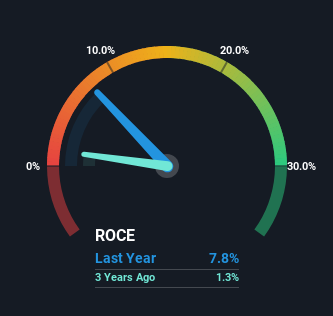Did you know there are some financial metrics that can provide clues of a potential multi-bagger? Ideally, a business will show two trends; firstly a growing return on capital employed (ROCE) and secondly, an increasing amount of capital employed. This shows us that it’s a compounding machine, able to continually reinvest its earnings back into the business and generate higher returns. Speaking of which, we noticed some great changes in Adient’s (NYSE:ADNT) returns on capital, so let’s have a look.
Return On Capital Employed (ROCE): What Is It?
For those who don’t know, ROCE is a measure of a company’s yearly pre-tax profit (its return), relative to the capital employed in the business. Analysts use this formula to calculate it for Adient:
Return on Capital Employed = Earnings Before Interest and Tax (EBIT) ÷ (Total Assets – Current Liabilities)
0.078 = US$446m ÷ (US$9.3b – US$3.5b) (Based on the trailing twelve months to December 2023).
Therefore, Adient has an ROCE of 7.8%. In absolute terms, that’s a low return and it also under-performs the Auto Components industry average of 12%.
View our latest analysis for Adient
Above you can see how the current ROCE for Adient compares to its prior returns on capital, but there’s only so much you can tell from the past. If you’re interested, you can view the analysts predictions in our free analyst report for Adient .
The Trend Of ROCE
Adient has not disappointed with their ROCE growth. The figures show that over the last five years, ROCE has grown 72% whilst employing roughly the same amount of capital. So it’s likely that the business is now reaping the full benefits of its past investments, since the capital employed hasn’t changed considerably. It’s worth looking deeper into this though because while it’s great that the business is more efficient, it might also mean that going forward the areas to invest internally for the organic growth are lacking.
Our Take On Adient’s ROCE
In summary, we’re delighted to see that Adient has been able to increase efficiencies and earn higher rates of return on the same amount of capital. And a remarkable 121% total return over the last five years tells us that investors are expecting more good things to come in the future. With that being said, we still think the promising fundamentals mean the company deserves some further due diligence.
Since virtually every company faces some risks, it’s worth knowing what they are, and we’ve spotted 2 warning signs for Adient (of which 1 is a bit unpleasant!) that you should know about.
While Adient isn’t earning the highest return, check out this free list of companies that are earning high returns on equity with solid balance sheets.
Have feedback on this article? Concerned about the content? Get in touch with us directly. Alternatively, email editorial-team (at) simplywallst.com.
This article by Simply Wall St is general in nature. We provide commentary based on historical data and analyst forecasts only using an unbiased methodology and our articles are not intended to be financial advice. It does not constitute a recommendation to buy or sell any stock, and does not take account of your objectives, or your financial situation. We aim to bring you long-term focused analysis driven by fundamental data. Note that our analysis may not factor in the latest price-sensitive company announcements or qualitative material. Simply Wall St has no position in any stocks mentioned.
